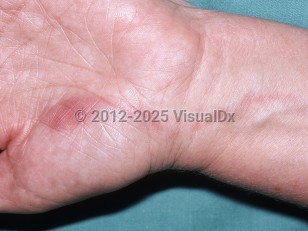Lymphangitis in Adult
Alerts and Notices
Important News & Links
Synopsis

Lymphangitis is an inflammation of the lymphatic system caused by introduction of foreign material, most commonly infectious. Penetrating trauma and spread of primary infection, such as cellulitis, erysipelas, or an abscess, are the most common causes of lymphangitis. Lymphangitis may be a sign of a worsening superficial infection. Clinicians should have a high level of concern, as cases of lymphangitis caused by group A streptococci have an increased risk of sepsis and subsequent morbidity and mortality.
Symptoms typically include a primary site of infection, due to either trauma or local infection, with erythematous streaks following the lymphatic vessels back toward regional lymph nodes. Tenderness and warmth can be found along the areas of erythema and over the lymph nodes, which can also be enlarged. Signs of systemic infection such as fever, chills, malaise, and loss of appetite can also be present and may indicate a more severe infection. The most common causative agent is group A beta-hemolytic streptococci followed by Staphylococcus aureus and Pseudomonas species. Viral as well as filarial causes have also been documented.
Variant presentations do exist, including nodular lymphangitis and sclerosing lymphangitis of the penis. Nodular lymphangitis is most commonly caused by Sporothrix schenckii, Nocardia brasiliensis, Mycobacterium marinum, Leishmania braziliensis, and Francisella tularensis. The presentation of nodular lymphangitis differs in that it presents with subcutaneous nodules along the infected, erythematous lymphatic vessels. Sclerosing lymphangitis of the penis, though rare, typically presents with a cordlike skin-colored lesion along the penile shaft or coronal sulcus. It is not an infection; its cause is not known. Many cases have an antecedent STD; perhaps inflammation is a trigger.
Patients with immunodeficiency are at increased risk of lymphangitis as well as progression to sepsis and treatment failure.
Risk factors for the development of lymphangitis include penetrating trauma or a primary source of infection, such as cellulitis. Underlying lymphedema, as may be seen after mastectomy and/or regional lymph node dissection, may also be a predisposing factor.
Pediatric Patient Considerations:
This population is more susceptible to infections by gram negative bacteria, and antibiotic choices may need to be tailored accordingly (second or third generation cephalosporins).
Immunocompromised Patient Considerations:
Immunocompromised patients are at increased risk of developing lymphangitis as well as systemic spread of infection. This population is also more susceptible to infections by gram negative bacteria, and antibiotic choices may need to be tailored accordingly (second or third generation cephalosporins).
Symptoms typically include a primary site of infection, due to either trauma or local infection, with erythematous streaks following the lymphatic vessels back toward regional lymph nodes. Tenderness and warmth can be found along the areas of erythema and over the lymph nodes, which can also be enlarged. Signs of systemic infection such as fever, chills, malaise, and loss of appetite can also be present and may indicate a more severe infection. The most common causative agent is group A beta-hemolytic streptococci followed by Staphylococcus aureus and Pseudomonas species. Viral as well as filarial causes have also been documented.
Variant presentations do exist, including nodular lymphangitis and sclerosing lymphangitis of the penis. Nodular lymphangitis is most commonly caused by Sporothrix schenckii, Nocardia brasiliensis, Mycobacterium marinum, Leishmania braziliensis, and Francisella tularensis. The presentation of nodular lymphangitis differs in that it presents with subcutaneous nodules along the infected, erythematous lymphatic vessels. Sclerosing lymphangitis of the penis, though rare, typically presents with a cordlike skin-colored lesion along the penile shaft or coronal sulcus. It is not an infection; its cause is not known. Many cases have an antecedent STD; perhaps inflammation is a trigger.
Patients with immunodeficiency are at increased risk of lymphangitis as well as progression to sepsis and treatment failure.
Risk factors for the development of lymphangitis include penetrating trauma or a primary source of infection, such as cellulitis. Underlying lymphedema, as may be seen after mastectomy and/or regional lymph node dissection, may also be a predisposing factor.
Pediatric Patient Considerations:
This population is more susceptible to infections by gram negative bacteria, and antibiotic choices may need to be tailored accordingly (second or third generation cephalosporins).
Immunocompromised Patient Considerations:
Immunocompromised patients are at increased risk of developing lymphangitis as well as systemic spread of infection. This population is also more susceptible to infections by gram negative bacteria, and antibiotic choices may need to be tailored accordingly (second or third generation cephalosporins).
Codes
ICD10CM:
I89.1 – Lymphangitis
SNOMEDCT:
1415005 – Lymphangitis
I89.1 – Lymphangitis
SNOMEDCT:
1415005 – Lymphangitis
Look For
Subscription Required
Diagnostic Pearls
Subscription Required
Differential Diagnosis & Pitfalls

To perform a comparison, select diagnoses from the classic differential
Subscription Required
Best Tests
Subscription Required
Management Pearls
Subscription Required
Therapy
Subscription Required
References
Subscription Required
Last Updated:11/11/2021
Lymphangitis in Adult

